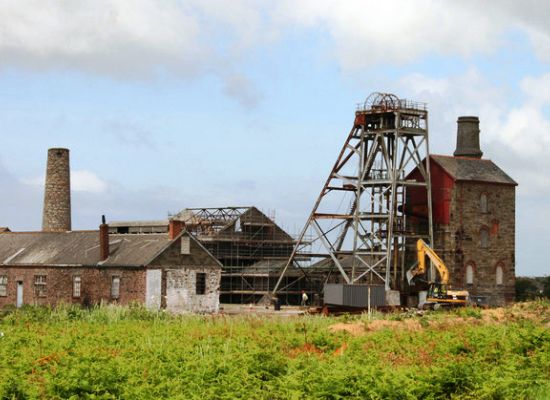 |
Northern Mine Research Society Registered Charity 326704 |
South Crofty Mine
 |
© Copyright Helen Wilkinson and licensed for reuse under this Creative Commons Licence |
A new company, South Crofty Ltd, took over in 1906 and began modernising the mine. The addition of magnetic separators allowed the recovery of tungsten ore from the black tin, thereby adding to income until its price fell in 1919.
Large tonnages of arsenic were also recovered from old workings. The profits were used for further modernisation which reduced working costs and allowed the mine to survive the slumps of the early 1920s and 30s, when neighbouring mines closed and were added to the set. Some of the latter, for example, Cooks Kitchen, Dolcoath and East Pool, had been very rich.
Robinson's Shaft was an old shaft which was enlarged and sunk vertically to below the 265 fathom level, between 1900 and 1912, and used for pumping. The engine is still in-situ.
Cook's Shaft, a new vertical shaft, sunk from 1907 and used for winding ore.
In January 1922, work began on sinking Taylor's shaft to a depth of 1700 feet. It was fitted with a 90 inch pumping engine which was brought from the nearby Carn Brea Mine in 1924. The engine now belongs to the National Trust.
East Pool Mine: In 1921 old stopes collapsed and blocked the East Pool pumping and Michell's winding shafts, putting them out of action.
When a collapse in world tin prices forced its closure, in March 1998, South Crofty included many older mines and covered many times its original area.
Underground prospecting resumed in 2001 and, with the likelihood that the current high metal prices will endure, mining may resume.
Further reading:
- Bullen, L.J. (1993) "A day at South Crofty Mine in 1944", British Mining No.48, pp.55-64
- Dominy, S.C., Bussell, M.A. & Camm, G.S. (1996) "Geology and mining of complex narrow veins in south-west England: an example from South Crofty Tin Mine, Camborne, Cornwall." British Mining No.57, pp.150-170